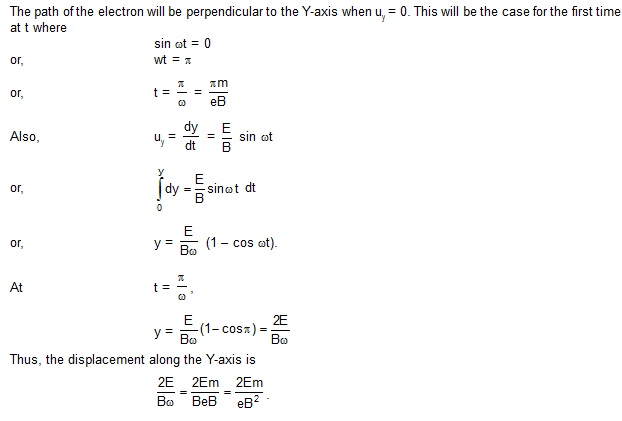Solved Examples
![]()
(a) Find the force on the proton just after it is projected. (b) What is the acceleration produced?
Sol.
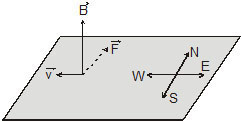
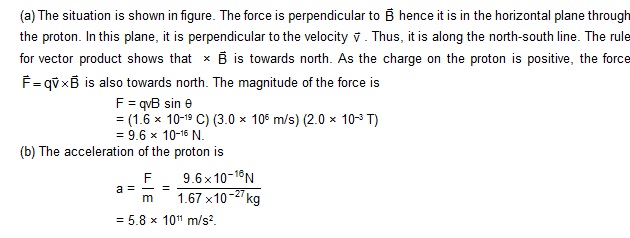
34.2 A particle having a charge of 100 mC and a mass of 10 mg is projected in a uniform magnetic field of 25 mT
with a speed of 10 m/s. If the velocity is perpendicular to the magnetic field, how long will it take for the
particle to come back to its original position for the first time after being projected.

34.3 Figure shows a triangular loop PQR carrying a current i. The triangle is equilateral with edge-length l.
A uniform magnetic field B exists in a direction parallel to PQ. Find the forces acting on the three wire PQ, QR and RP separately.
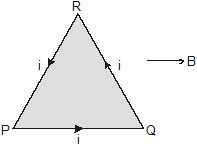

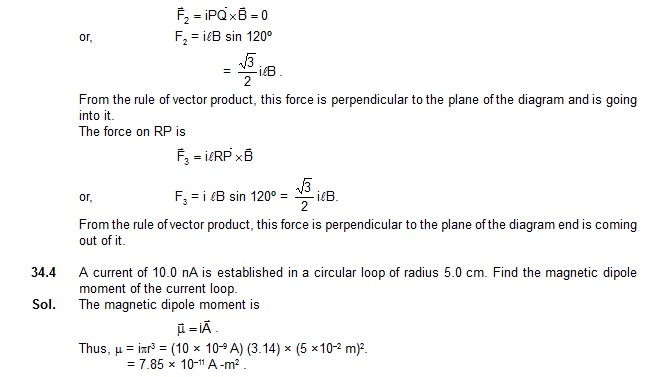
Questions for Short answer
1. Suppose a charged particle moves with a velocity v near a wire carrying an electric current. A magnetic force,
therefore, acts on it. If the same particle is seen from a frame moving with velocity v in the same direction,
the charge will be found at rest. Will the magnetic force become zero in this frame ?
Will the magnetic field become zero in this frame ?
2. Can a charged particle be accelerated by a magnetic field ? Can its speed be increased ?
3. Will a current loop placed in a magnetic field always experiment a zero force ?
4. The free electrons in a conducting wire are in constant thermal motion. If such a wire,
carrying no current, is placed in a magnetic field, is there a magnetic force on each free electron ? On the wire ?
5. Assume that the magnetic field is uniform in a cubical region and is zero outside. Can you project a charged
particle from outside into the field so that the particle describes a complete circle in the field ?
6. An electron beam projected along the positive X–axis deflects along the positive Y–axis.
If this deflection is caused by a magnetic field, what is the direction of the field ?
Can we conclude that the field is parallel to the Z–axis ?
7. Is it possible for a current loop to stay without rotating in a uniform magnetic
field > If yes, what should be the orientation of the loop ?
8. The net charge in a current–carrying wire is zero. Then, why does a magnetic field exert a force on it ?
![]()
10. Verify that the units weber and volt–second are the same.
Objective - I
1. A positively charged particle projected towards east os deflected towards north by a magnetic field. The field may be -
(A) towards west (B) towards south (C) upward (D*) downward
2. A charged particle is whirled in a horizontal circle on a frictionless table by attaching it to a string fixed at one point.
If a magnetic field is switched on in the vertical direction, the tension in the string.
(A) will increase (B) will decrease (C) will remain the same (D*) may increase or decrease
3. Which of the following particles will describe the smallest circle when projected with the
same velocity perpendicular to a magnetic field ?
(A) electron (B) proton (C) He+ (D*) Li+
4. Which of the following particles will have minimum frequency of revolution
when projected with the same velocity perpendicular to a magnetic field ?
(A*) electron (B) proton (C) He+ (D) Li+
5. Which of the following particles will have minimum frequency of revolution
when projected with the same velocity perpendicular to a magnetic field ?
(A) electron (B) proton (C) He+ (D*) Li+
6. A circular loop of area 1 cm2, carrying a current of 10 A, is placed in a magnetic field of 0.1
T perpendicular to the plane of the loop. The torque on the loop due to the magnetic field is
(A*) zero (B) 10-4 N-m (C) 102 N-m (D) 1 N-m
7. A beam consisting of protons and electrons moving at the same speed goes through a
thin region in which there is a magnetic field perpandicular to the beam. The protons and the electrons
(A) will go undeviated
(B) will be deviated by the same angle will not separate
(C*) will be deviated by different angles and hence separate
(D) will be deviated by the same angle but will separate.
8. A charged particle moves in a uniform magnetic field. The velocity of the particle
at some instant makes an acute angle with the magnetic field. The path of the particle will be.
(A) a straight line (B) a circle
(C*) a helix with uniform pitch (D) a helix with nonuniform pitch.
9. A particle moves in a region having a uniform magnetic field and a parallel, uniform electric field.
At some instant, the velocity of the particle is perpendiculars to the field direction. The path of the particle will be
(A) a straight line (B) a circle
(C) a helix with uniform pitch (D*) a helix with nonuniform pitch.
10. An electric current i enters and leaves a uniform circular wire of radius a through diametrically opposite points.
A charged particle q moving along the axis of the circular wire passes through its centre at speed u.
The magnetic force acting on the particle when it passes through the centre has a magnitude

Objective - II
1. If a charged particle at rest experieces no electromagnetic force,
(A*) the electric field must be zero (B) the magnetic field must be zero
(C) the electric field may or may not be zero (D*) the magnetic field may or may not be zero
2. If a charged particle kept at list expreiences an electromagnetic force,
(A*) the electric field must not be zero (B) the magnetic field must not be zero
(C) the electric field may or may not be zero (D*) the magnetic field may no may not be zero
3. If a charged particle projected in a gravity-free room deflects,
(A) there must be an electric field (B) there must be a magnetic field
(C*) both field cannot be zero (D*) both fields can be nonzero
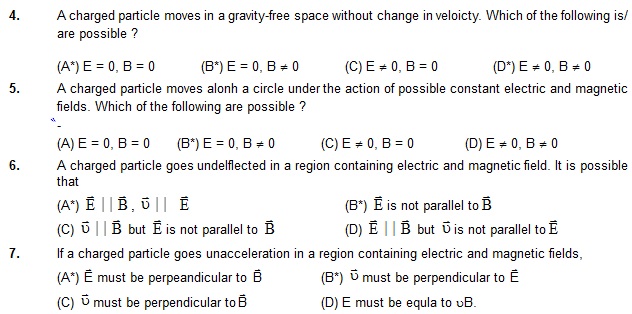
8. Two ions have equla masses but one is singly-ionized and other is douly-ionized.
The are project from the same place in a uniform magnetic field with the same
veloicty perpendicular to the field.
(A) Both ions will go along circles of equal radii.
(B*) The circle described by the single-ionized charge will have a radius double that of the other circle
(C) The two circles do not touch each other
(D*) The two circles touch each other
9. An electron is moving along the positive X-axis. You want to apply a magnetic field for
a short time so that the electron may reverse its direction and move parallel to the negative
X-axis. This can be done by applying the magentic field along.
(A*) Y-axis (B*) Z-axis (C) Y-axis only (D) Z-axis only
10. Let and denote electric and magnetic fields in a frames S and ’ and ’ in another frame S’
moving with respect to S at a velocity. Two of the following equations are wrong. Identify them.

Worked Out Examples
1. A charge of 2.0 C moves with a speed of 2.0 × 106 m/s along the positive X-axis.
A magnetic field B of strength (0.20 j + 0.40k )T exists in space. Find the magnetic force acting on the charge.

2. A wire is bent in the form of an equilateral triangle PQR of side 10 cm and carries a current of 5.0 A.
It is placed in a magnetic field B of magnitude 2.0 T directed perpendicularly to the plane of the loop.
Find the forces on the three sides of the triangle.
Sol.
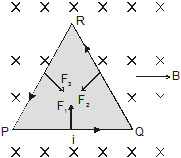
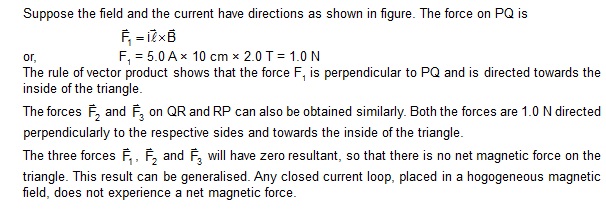
3. Figure shows two long metal rails placed horizontally and parallel to each other at a separation l.
A uniform magnetic field B exists in the vertically downward direction. A wire of mass m can slide on the rails.
The rails are connected to a constant current source which drives a current i in the circuit.
The friction coefficient between the rails and the wire is m. (a) What soluble the minimum value of m which
can prevent the wire from sliding on the rails? (b) Describe the motion of the wire if the value of m is half the
value found in the previous part

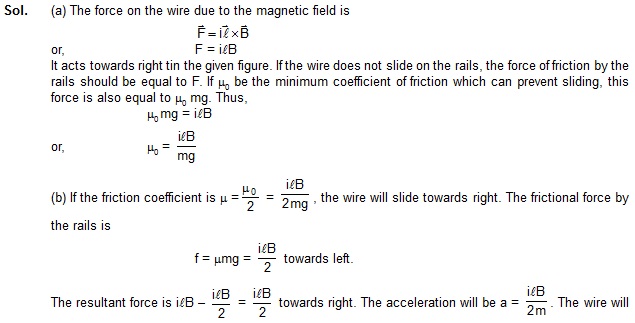
4. A proton, a deuteron and an alpha particle moving with equal kinetic enter perpendicularly into a magnetic field.
If rp, rd and ra are the respective radii of the circular paths, find the ratio rp/ rd and rp/rn.
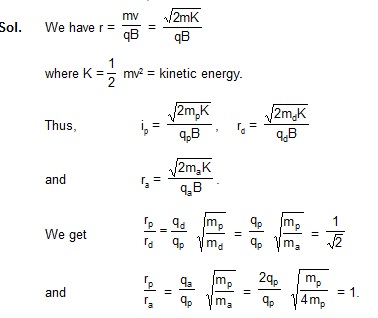
5. Singly charged magnesium (A = 24) ions are accelerated to kinetic energy 2 keV and are projected perpendicularly
into a magnetic field B of magnitude 0.6 T. (a) Find the radius of the circle formed by the ions.
(b) If there are also singly charged ions of the isotope magnesium-26, what would be the radius for these particles?
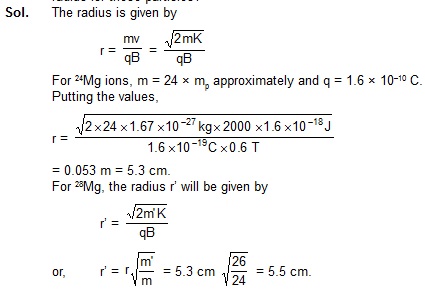
6. A particle having a charge 20 mC and mass 20 mg moves along a circle of radius 5.0 cm under the action of
a magnetic field B = 1.0 T. When the particle is at a point P, a uniform electric field is switched on and it is
found that the particle continues on the tangent through P with a uniform velocity. Find the electric field.
Sol.
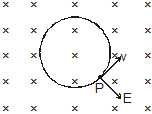
When the particle moves along a circle in the magnetic field B, the magnetic force is radially inward.
If an electric field of proper magnitude is switched on which is directed radially outwards,
the particle may experience no force. It will then move along a straight line with uniform velocity.
This will be the case when
qE = qvB or, E = vB,
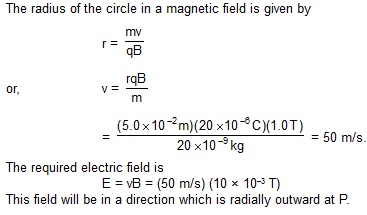
7. A particle of mass m = 1.6 × 10–27 kg and charge q = 1.6 × 10–19 C moves at a speed of 1.0 × 10–7 m/s.
It enters a region of uniform magnetic field at a point E, as shown in figure. The field has a strength of 1.0 T.
(a) The magnetic field is directed into the plane of the paper. The particle leaves the region of the field at the point F.
Find the distance EF and the angle q. (b) If the field is coming out of the paper, find the time spent by
the particle in the region of the magnetic field after entering it at E.
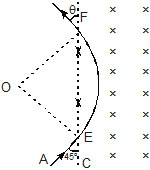
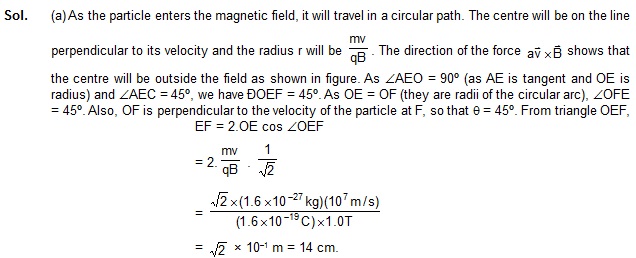
(b)
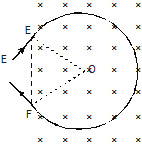

8. A beam of protons with a velocity of 4 × 105 m/s enters a uniform magnetic field of 0.3 T.
The velocity makes an angle of 60º with the magnetic field. Field the radius of the helical
path taken by the proton beam and the pitch of the helix.
Sol. The components of the proton’s velocity along and perpendicular to the magnetic field are
vu = (4 × 105 m/s) cos 60º = 2 × 105 m/s.
and v1 = (4 × 105 m/s) sin 60º = 2/3 × 105 m/s.
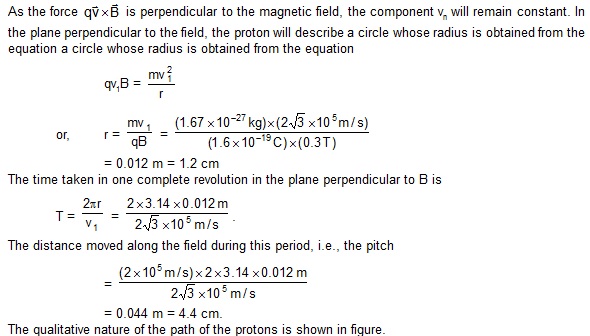
9.

10. An electron moves with a constant speed v along a circle of radius r.
(a) Find the equivalent current through a point on its path.
(b) Find the magnetic moment of the circulating electron.
(c) Find the ratio of the magnetic moment of the angular momentum of the electron.
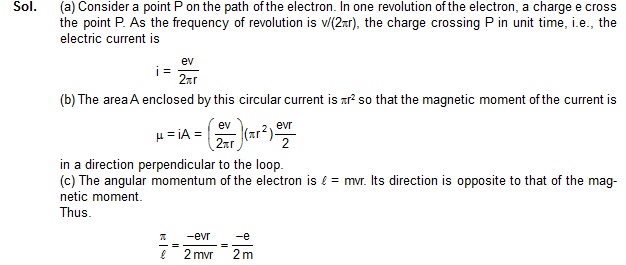
.
11. An electron is released from the origin at a place where a uniform electric field E and a uniform magnetic
field B exist along the negative Y-axis and the negative Z-axis respectively. Find the displacement of the
electron along the Y-axis when its velocity becomes perpendicular to the electric field for the first time.
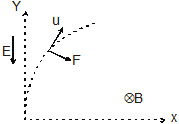
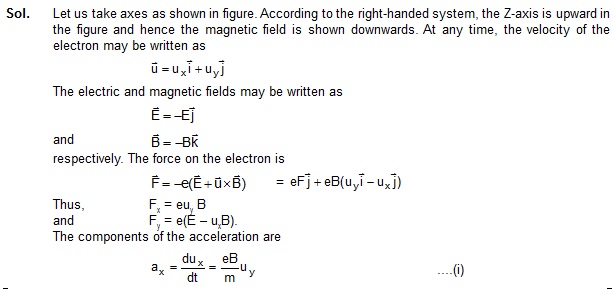
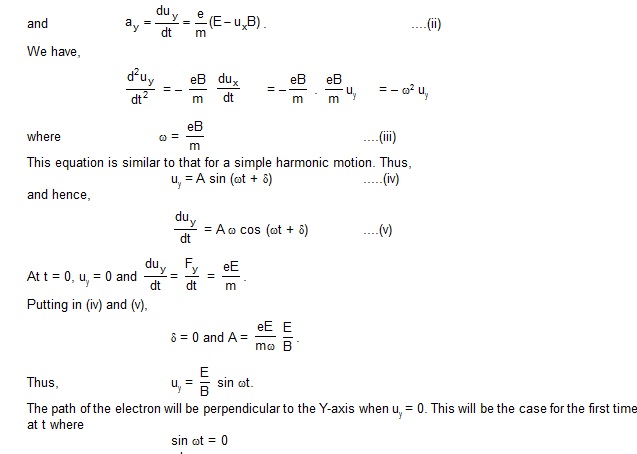
.
